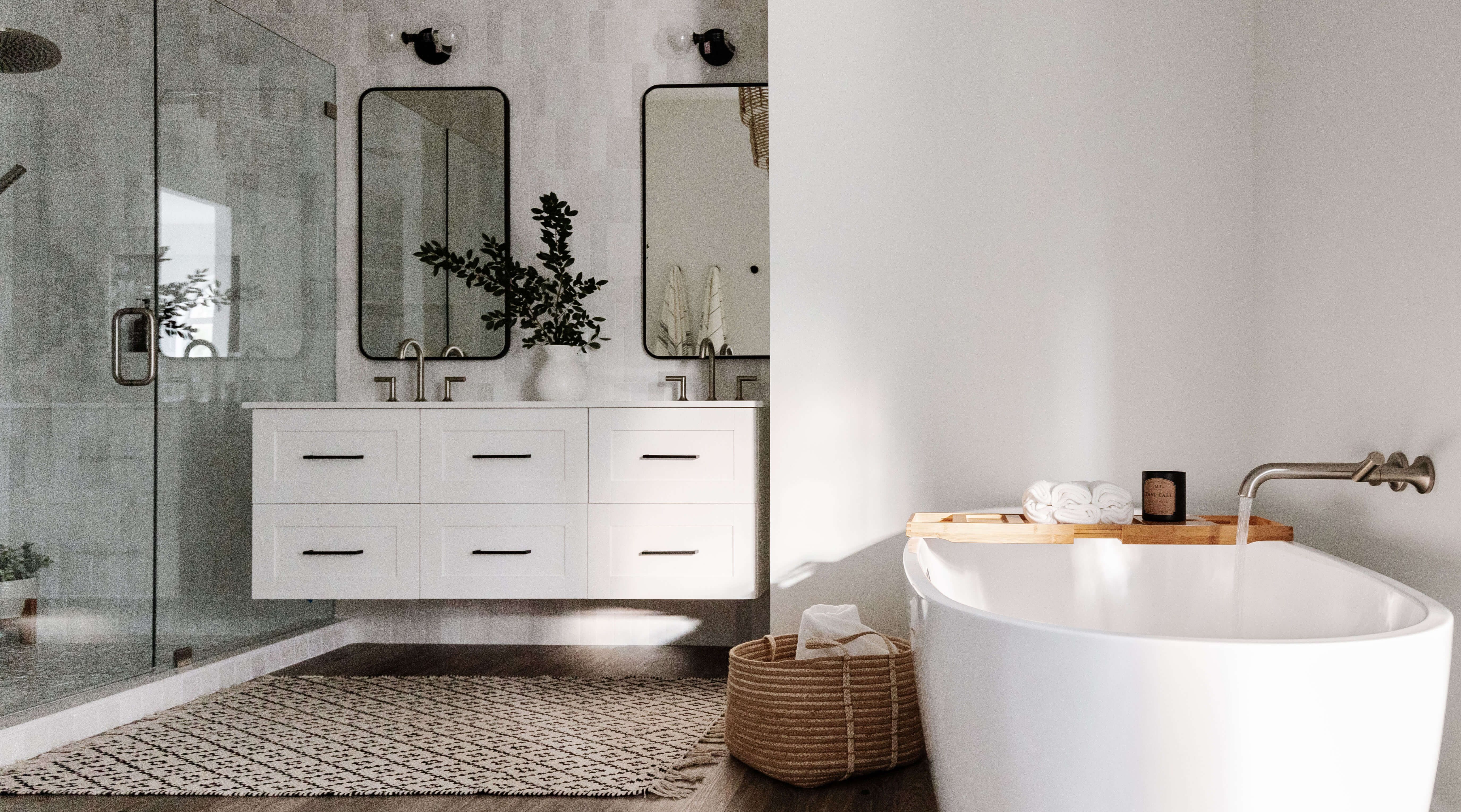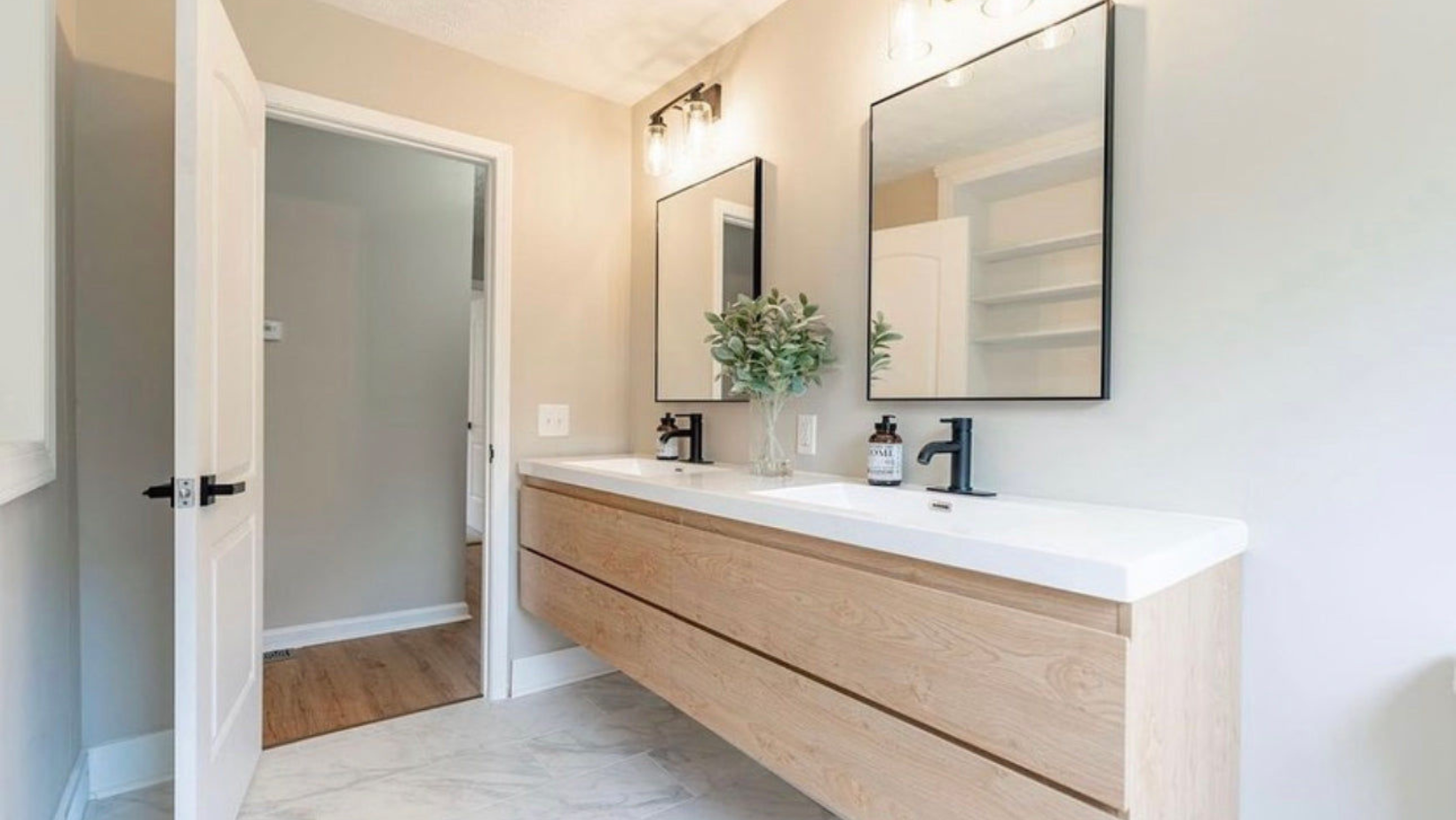Choosing the Right Free-Standing Vanity

Free-standing vanities offer a unique blend of style and functionality, adding a touch of elegance and sophistication to your bathroom. However, selecting the right free-standing vanity requires careful consideration of various factors, including space availability, desired style, and material preferences.
Advantages and Disadvantages of Free-Standing Vanities
Free-standing vanities offer a distinct advantage over wall-mounted vanities by providing a more substantial and visually striking presence. They create a focal point within the bathroom, adding a touch of grandeur and enhancing the overall design aesthetic.
- Advantages:
- Enhanced Aesthetics: Free-standing vanities often boast intricate details and unique designs, adding a touch of elegance and sophistication to the bathroom.
- Increased Storage: With ample cabinet space, free-standing vanities provide ample storage for bathroom essentials, keeping the space organized and clutter-free.
- Versatility: These vanities can be placed anywhere in the bathroom, allowing for greater flexibility in design and layout.
- Improved Durability: Free-standing vanities are typically more robust and durable than wall-mounted vanities, capable of withstanding heavy use and time.
- Disadvantages:
- Space Requirements: Free-standing vanities require more floor space than wall-mounted vanities, which may be a limitation in smaller bathrooms.
- Installation Complexity: Installation can be more challenging compared to wall-mounted vanities, requiring careful plumbing and electrical connections.
- Cost: Free-standing vanities tend to be more expensive than wall-mounted vanities, particularly those with intricate designs or high-quality materials.
Measuring the Space for a Free-Standing Vanity
Accurately measuring the available space is crucial for selecting a vanity that fits seamlessly into your bathroom.
- Width: Measure the available wall space where you intend to place the vanity. Ensure adequate clearance for doors and other fixtures.
- Depth: Measure the distance from the wall to the opposite side of the bathroom. Allow sufficient space for comfortable movement around the vanity.
- Height: Determine the desired height of the vanity, considering your personal preference and the overall bathroom design.
Comparing Vanity Styles
Different vanity styles cater to diverse bathroom aesthetics, allowing you to create a unique and personalized space.
- Traditional: Characterized by ornate details, intricate carvings, and classic designs, traditional vanities exude a timeless elegance and create a sense of sophistication.
- Modern: Modern vanities prioritize clean lines, minimalist designs, and sleek finishes, creating a contemporary and stylish look.
- Farmhouse: Farmhouse vanities feature rustic charm, distressed finishes, and natural materials, adding a touch of warmth and character to the bathroom.
- Contemporary: Contemporary vanities blend modern and traditional elements, creating a balanced and sophisticated aesthetic.
Material Choices for Vanity Construction
Material selection plays a significant role in determining the durability, maintenance requirements, and aesthetic appeal of your vanity.
- Wood: Known for its natural beauty, durability, and versatility, wood is a popular choice for vanity construction. Oak, maple, cherry, and walnut are commonly used, each offering distinct grain patterns and colors.
- Marble: Marble exudes elegance and sophistication, adding a touch of luxury to the bathroom. Its natural veining patterns create a unique and visually striking look.
- Acrylic: Acrylic is a durable and water-resistant material, offering a smooth and easy-to-clean surface. It is also available in a wide range of colors and finishes.
Comparing Vanity Materials
| Material | Pros | Cons |
|---|---|---|
| Wood | Natural beauty, durability, versatility | Susceptible to water damage, requires regular maintenance |
| Marble | Elegant, luxurious, unique veining patterns | Porous, requires sealing, susceptible to staining |
| Acrylic | Durable, water-resistant, easy to clean | May not have the same natural beauty as wood or marble |
Features and Functionality
A free-standing vanity is a beautiful and functional addition to any bathroom, offering a unique blend of style and practicality. It’s more than just a place to wash your hands; it’s a statement piece that elevates the ambiance of your bathroom. To maximize its potential, it’s crucial to understand the diverse features and functionalities that come with this type of vanity.
Sink Types
The sink is the heart of any vanity, and its choice significantly impacts the overall look and functionality. Free-standing vanities offer a variety of sink options, each with its own advantages and drawbacks.
- Vessel Sinks: These stylish sinks sit atop the countertop, creating a dramatic and modern aesthetic. They are available in various materials, from ceramic to stone, offering a wide range of design choices. Vessel sinks are generally smaller than other types, making them ideal for smaller bathrooms. However, they can be less practical for everyday use, as water can splash onto the countertop.
- Undermount Sinks: As the name suggests, undermount sinks are installed beneath the countertop, creating a seamless and sleek look. They are known for their easy cleaning and spaciousness. However, they require a specific countertop material and installation expertise.
- Drop-in Sinks: Drop-in sinks are the most traditional and budget-friendly option. They are simply dropped into a cutout in the countertop. While they are simple to install, they can sometimes appear less elegant than other options.
Storage Options, Free standing bathroom vanity
Free-standing vanities are designed to provide ample storage for your bathroom essentials. Understanding the various storage options available helps you choose a vanity that perfectly suits your needs.
- Drawers: Drawers offer a convenient way to store toiletries, towels, and other items. They are ideal for keeping your bathroom organized and clutter-free.
- Cabinets: Cabinets provide larger storage space, perfect for storing bulkier items like towels or cleaning supplies. They are typically equipped with shelves, making it easy to access and organize your belongings.
- Shelves: Open shelves are a great way to display decorative items or frequently used products. They are also a good option for smaller bathrooms where space is limited.
Countertop Material
The countertop is a significant element of a free-standing vanity, both in terms of functionality and aesthetics. It’s essential to choose a material that balances durability and style.
- Granite: Granite is a natural stone known for its durability and beauty. It comes in a wide variety of colors and patterns, allowing you to create a unique look. However, it can be expensive and requires regular sealing to maintain its shine.
- Quartz: Quartz is an engineered stone that offers exceptional durability and resistance to stains and scratches. It comes in a wide range of colors and patterns, making it a versatile option. Quartz is also non-porous, making it easy to clean.
- Laminate: Laminate is a cost-effective and durable option. It comes in a variety of colors and patterns, mimicking the look of natural stone. However, it is not as resistant to scratches and heat as granite or quartz.
Faucet Selection
The faucet is the final touch that completes the look of your free-standing vanity. Choosing the right faucet is crucial for both style and functionality.
- Style: Consider the overall style of your bathroom when selecting a faucet. Modern vanities often feature sleek, minimalist faucets, while traditional bathrooms might opt for more ornate designs.
- Functionality: Think about your daily needs. Do you need a faucet with a pull-out spray head for easy cleaning? Or would a single-handle faucet be more convenient?
- Water Pressure: If you have low water pressure, consider a faucet with a higher flow rate.
Sink, Countertop, and Faucet Comparison
| Feature | Vessel Sink | Undermount Sink | Drop-in Sink | Granite Countertop | Quartz Countertop | Laminate Countertop | Modern Faucet | Traditional Faucet |
|---|---|---|---|---|---|---|---|---|
| Style | Modern, Dramatic | Sleek, Seamless | Traditional | Natural, Elegant | Modern, Versatile | Budget-friendly | Minimalist, Sleek | Ornate, Decorative |
| Durability | Variable (depending on material) | High | Moderate | High | Very High | Moderate | High | High |
| Maintenance | Variable | Easy | Easy | Requires sealing | Low maintenance | Low maintenance | Easy | Easy |
| Cost | Variable | Moderate to High | Low | High | Moderate to High | Low | Moderate to High | Moderate to High |
Installation and Maintenance: Free Standing Bathroom Vanity

Installing a free-standing vanity is a relatively straightforward process, requiring basic DIY skills and a few essential tools. Proper installation ensures stability, functionality, and longevity, while regular maintenance keeps your vanity looking its best and extends its lifespan.
Installation Steps
The installation process involves several steps, ensuring a secure and functional setup.
- Prepare the Area: Clear the area around the intended location of the vanity. Remove any existing fixtures or obstructions, and ensure the floor is level.
- Position the Vanity: Carefully position the vanity in its desired location, ensuring it is centered and aligned with the wall.
- Connect the Plumbing: Connect the vanity’s water supply lines to the existing plumbing, using appropriate fittings and securing them tightly.
- Secure the Vanity: Attach the vanity to the wall using appropriate brackets or anchors, ensuring it is securely fastened.
- Install the Sink and Faucet: Install the sink and faucet according to the manufacturer’s instructions.
- Connect the Drain: Connect the vanity’s drainpipe to the existing waste line, ensuring a secure and leak-proof connection.
- Test the Installation: Turn on the water supply and check for any leaks or malfunctions.
Tools and Materials
The following tools and materials are typically required for installing a free-standing vanity:
- Level: To ensure the vanity is installed level and stable.
- Tape Measure: To measure the dimensions of the vanity and the space.
- Pencil: To mark the installation points.
- Screwdriver: To secure the vanity to the wall and assemble the sink and faucet.
- Wrench: To tighten plumbing connections.
- Pliers: To manipulate plumbing fittings.
- Caulk: To seal gaps and prevent leaks.
- Plumbers Tape: To seal threaded connections.
- Safety Glasses: To protect your eyes from debris.
- Gloves: To protect your hands from cuts and abrasions.
Ventilation
Proper ventilation is crucial to prevent moisture buildup and damage to the vanity. Moisture can cause warping, mold growth, and other problems, especially in bathrooms, which are naturally humid environments.
- Exhaust Fan: Install an exhaust fan in the bathroom to remove excess moisture and maintain a balanced humidity level.
- Window Ventilation: If available, open a window for natural ventilation, especially after showering or bathing.
- Avoid Overcrowding: Ensure adequate space around the vanity for airflow and prevent moisture buildup.
Maintenance
Regular maintenance is essential to keep your free-standing vanity in top condition and extend its lifespan. This involves cleaning and care routines that are tailored to the material of the vanity.
- Cleaning: Clean the vanity regularly with a mild cleaner and a soft cloth. Avoid harsh chemicals or abrasive cleaners that can damage the finish.
- Wood Vanities: Apply a wood polish or sealant periodically to protect the wood from moisture and wear.
- Stone Vanities: Clean stone vanities with a specialized stone cleaner to prevent etching and maintain the natural beauty of the stone.
- Acrylic Vanities: Acrylic vanities are easy to clean and maintain, but avoid using abrasive cleaners that can scratch the surface.
Maintenance Checklist
A routine maintenance checklist helps ensure your vanity stays in top condition.
- Clean the vanity regularly.
- Inspect the vanity for any signs of damage or wear.
- Tighten any loose screws or fittings.
- Check the plumbing connections for leaks.
- Apply sealant or polish as needed.
- Clean the drain regularly to prevent clogs.
- Ensure proper ventilation to prevent moisture buildup.
